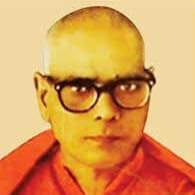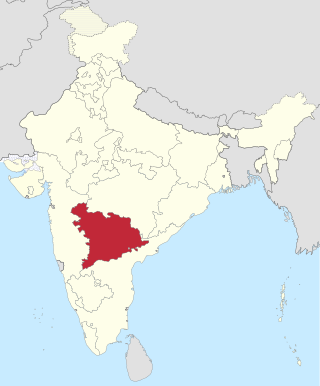Related Research Articles

Hyderabad State was an independent monarchy/princely state/country located in the south-central Deccan region of Indian Subcontinent with its capital at the city of Hyderabad. It is now divided into the present-day state of Telangana, the Kalyana-Karnataka region of Karnataka, and the Marathwada region of Maharashtra in India.

The princely state of Hyderabad was annexed by India in September 1948 through a military operation code-named Operation Polo, which was dubbed a "police action".

Tanguturi Prakasam Panthulu was an Indian jurist, political leader, social reformer, and anti-colonial nationalist who served as the Prime Minister of the Madras Presidency. Prakasam subsequently became the first chief minister of the erstwhile Andhra State, created by the partition of Madras State along the linguistic lines. Prakasam was known as "Andhra Kesari" which translates to "Lion of Andhra". The Andhra Pradesh government issued G.O RT-2500 on 10 August 2014 declaring his birth anniversary a State holiday.

Kasim Razvi was a politician in the princely state of Hyderabad. He was the president of the Majlis-e-Ittehadul Muslimeen party from December 1946 until the state's accession to India in 1948. He was also the founder of the Razakar militia in the state. He held the levers of power with the Nizam of Hyderabad, blocking the possibilities of his accommodation with the Dominion of India.

The Razakars were the paramilitary volunteer force of the nationalist party in the Hyderabad State under the British Raj. Formed in 1938 by the Majlis-e-Ittehadul Muslimeen leader Bahadur Yar Jung, they expanded considerably during the leadership of Qasim Razvi around the time of Indian independence. They were deployed in the cause of maintaining Muslim rule in Hyderabad and resisting integration into India. Described as "enthusiastic" and "disciplined", they attacked and committed atrocities against Hindus and those who were launching a revolution against the Hyderabad State and the state's feudal lords like doras and deskhmukhs.
The Telangana Rebellion, natively known as Telangana Sayudha Poratam, was a communist-led insurrection of peasants against the princely state of Hyderabad in the region of Telangana that escalated out of agitations in 1944–46.

Kaloji Narayana Rao was an Indian poet, freedom fighter, anti-fascist and political activist of Telangana. He was awarded the Padma Vibhushan in 1992. The Telangana government honored Kaloji's birthday as Telangana Language Day.

Burgula Ramakrishna Rao was the second and last Chief Minister of the erstwhile Hyderabad State. Prior to the independence of India and the political integration of the princely states into the Union, he was among the Telugu-speaking leaders to resist the Nizam in the princely state of Hyderabad. He was a multi lingual academic, known for his scholarship in Sanskrit and Telugu. He was also a poet and translator.

Swami Ramanand Tirtha was an Indian politician, freedom fighter, educator and social activist who led the Hyderabad liberation struggle during the reign of Osman Ali Khan, the last Nizam of Hyderabad State. Swami Ramanand Tirtha was the principal leader of the Hyderabad State Congress. Before taking Sanyasa, his family name was Vyenkatesh Bhagvanrao Khedgikar.
Mallu Swarajyam was an Indian politician Women from Communist Party of India (Marxist) and Freedom fighter. She was member of an armed dalam which took part in the Telangana struggle. Her autobiography naa maate tupaakee tootaa was published by Hyderabad Book Trust in 2019.

Andhra Mahasabha was a people's organisation in the erstwhile Hyderabad state of India. It was an association started by Telugu people of Telangana region against Nizam rule. The people of Telangana formed the Andhra Mahasabha as they could not tolerate the injustice being done to the Telugu language and Telugu culture. In the late 1920s, under the leadership of Madapati Hanumantha Rao, the Telugu people united and formed a union and organized 13 Andhra Mahasabhas from 1930 to 1945. The activities of the Andhra Mahasabha in the Telangana region created awareness among the people against the Nizam and led to the armed struggle in Telangana. Chief among the people who led the Andhra Mahasabha were: Madapati Hanumantha Rao, Ravi Narayana Reddy, Suravaram Prathapareddy, Baddam Ella Reddy, Burgula Ramakrishna Rao, Dasarathi Krishnamacharya, Pulijala Venkatarangarao, Allampalli Venkatarama Rao, Kaloji Narayana Rao, Konda Venkata Rangareddy, Vattikota Alvaraswami, Potlapalli. Rama Rao, Arutla Ramachandra Reddy, and many more.
Chandra Rajeswara Rao was an Indian communist politician. He was one of the leaders of the Telangana Rebellion (1946–1951). He also worked as the Communist Party of India (CPI) general secretary for 28 years before giving up the post in 1992 due to health reasons.
Anabheri Prabhakar Rao was a Telangana communist guerrilla leader and is also considered a foremost authority of the Telugu language. He was an Indian freedom fighter, considered to be one of the most influential revolutionaries of the Indian independence movement. He was an intellectual, military theorist, diplomat and major figure of the Telangana Rebellion. He died fighting against the Nizam and Razakars.
The Comrades Association was a communist organization that operated in the State of Hyderabad in India during the rule of the Nizam. It represented the Communist Party of India in Hyderabad State. The Comrades Association played a very influential role in the Andhra Mahasabha. Revolutionary Urdu poets Makhdoom Mohiuddin and Raj Bahadur Gour were among the active figures in the Association. Along with three other groups, the Comrades Association was organized as the Nizam State Communist Committee in 1939, and played an active role in the Telangana Rebellion.
Nawab Moin Nawaz Jung was the Minister for Finance and External Affairs of the Hyderabad State, under the Nizam Osman Ali Khan's reign.

Hyderabad State was a state in Dominion and later Republic of India, formed after the accession of the State of Hyderabad into the Union on 17 September 1948. It existed from 1948 to 1956.

The Hyderabad State Forces were the armed forces of the princely state of Hyderabad. People from both India and abroad were recruited into the Forces. Among these groups were Arab nationals like Chaush and African nationals like Siddis who now stay in Barkas and A. C. Guards areas of Hyderabad respectively. The Hyderabad cavalry was chiefly composed of Muslim castes such as Mughals, Pathans, Syeds, Sheikhs and Balochs. They were principally recruited from the Deccan, but Delhi, Lucknow, Shahjahanpur, Sindh and Balochistan also supplied recruits to bolster ranks. These non-indigenous soldiers were known as the "Rohollas". The Hindus made a very small portion of the cavalry. The Nizam of Hyderabad also had about 1200 Sikh guards. Other battalions within the army were referred to with the suffix "-walas". Some troops were also supplied by the Europeans for the security of the Nizam.

The history of Telangana, located on the high Deccan Plateau, includes its being ruled by the Satavahana Dynasty, the Kakatiya Dynasty (1083–1323), the Musunuri Nayaks (1326–1356), the Delhi Sultanate, the Bahmani Sultanate (1347–1512), Golconda Sultanate (1512–1687) and Asaf Jahi dynasty (1724-1950).
Telangana Language Day is celebrated on 9 September every year in Telangana, India. This date was chosen on the occasion of renowned writer, poet of the Telangana Kaloji Narayana Rao's 100th birth anniversary. The Government of Telangana provides funds and awards for the improvement of Telangana dialect of Telugu.
A standstill agreement was an agreement signed between the newly independent dominions of India and Pakistan and the princely states of the British Indian Empire prior to their integration in the new dominions. The form of the agreement was bilateral between a dominion and a princely state. It provided that all the administrative arrangements, existing between the British Crown and the state would continue unaltered between the signatory dominion and the princely state, until new arrangements were made.
References
- 1 2 3 "HYDERABAD: The Holdout". Time. 30 August 1948. Archived from the original on 1 December 2008. Retrieved 13 August 2010.
- 1 2 Benichou, Autocracy to Integration 2000, Chapter 2.
- 1 2 3 4 5 Benichou, Autocracy to Integration 2000, Chapter 3.
- 1 2 Smith, Hyderabad Muslim Tragedy 1950, pp. 32, 42.
- 1 2 3 Santosh Kaul (1998). Indian Freedom Movement and States. Anmol Publications. pp. 130–60. ISBN 978-81-7488-916-4.
- 1 2 Shankaragouda Hanamantagouda Patil (2002). Community dominance and political modernisation: the Lingayats. Mittal Publications. pp. 220–60. ISBN 978-81-7099-867-9.